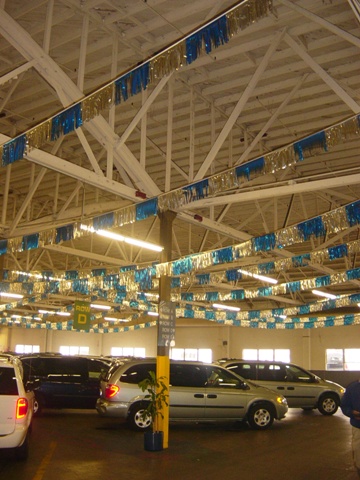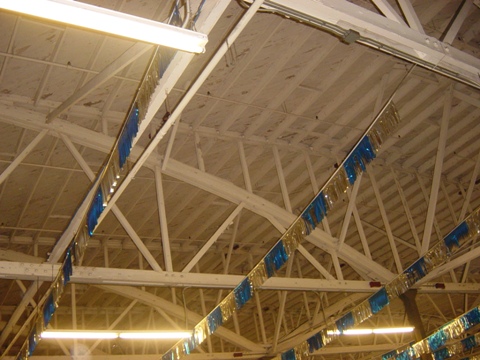Everyone in the fire service should know and understand the dangers associated with the bowstring truss style of roof construction. Unfortunately the fire service learned this during due to two tragic bowstring truss roof collapse events:
August 2, 1978- Brooklyn (NY) when 6 brothers lost their lives
July 1, 1988- Hackensack (NJ) when 5 brothers lost their lives
It is extremely important to be able to identify when a bowstring truss is present. Hopefully every firefighter should be able to identify a bowstring truss by the tell-tale arched roof. However, in many bowstring truss installations the arch is concealed from street level view by a large parapet wall like shown in our previous posts titled: Opposing Forces and Cover that Bowstring.
Besides the arch, the next most prevalent sign of bowstring is an occupancy that has a large open area, with a limited amount of supporting columns. Some examples include: bowling alleys, supermarkets, and automotive dealers/repair shops. The age of the building may provide another clue: Bowstring trusses were extremely popular prior to 1960’s.
The pictures below show a different way of hiding the bowstring and prove that it’s just as important to know the other signs of a bowstring truss roof.


As you can see from these photos, the arch of the roof may not be noticeable at all from the outside. Upon observation from the inside, the presence of the bowstring becomes obvious. The bowstring is present, but it has been “built up” into a flat roof. This particular building houses an indoor parking area for a rental car company located near the Los Angeles (CA) airport. Since the occupancy required a large open span, with a minimal amount of columns, the bowstring truss was utilized. Actually, to be more accurate, three bowstring trusses were used to make up each row of a truss. Each bowstring spanned a third of the building’s width. The bowstring truss was then built-up to make to roof flat for drainage purposes, totally concealing the arch.
So the most reliable way to tell if a bowstring is present is to make that determination prior to the incident. Like we have preached so many times in the past, get out and pre-plan!

THis is another example of why our pre-incident plans are so helpful!
i’d hate to be the engineer that “stamped” that
I agree that a bowstring truss is dangerous to firefighters and preplans are important and the best way to identify them. It is hard to tell from the photos but that may be a rib arch truss instead of a bowstring. The bottom chord on a bowstring truss is held together with a rod and turn buckle, that when heated expands causing failure and roof collapse. A heavy timber rib arch truss does have the similar arched roof but does not present the same catasrophic failure dangers of a bowstring.
Not that it really makes any differance in your story but another bowstring collapse worth mentioning would be the Yingling Chevrolet bowstring collapse on November 21, 1968 in Wichita Kansas that claimed the life of 4 Wichita firefighters.
Isnt a rib arch that sandwich Mickey Ds sells every so often?
Actually we all know what a rib arch is, or atleast have all seen one…or a hundred. Rib arches are very popular for short span bridges. It is almost the opposite of a bowstring truss. It is a common arch with the load supported atop the arch, “ribbing” is using multiple arches in a parallel manner to cut down on bulk/weight and increase load ratio. If you look at a bridge and it has an arch underneath that has columns rising from the arch up to the road it supports, look closely and you will see multiple arches parallel. (you have a ribbed arch). This system could be considered a ribbed for our practical but not technical purposes.
BOWSTRING. OK this type construction (not the picture)started out as Bowstring Arch, which is as Tom described. Failure of which is CATASTROPHIC. i.e. walls pushing out forcefully and collapsing with large scale, if not total, roof collapse. This method was replaced by the Bowstring (for the concept and previously named arch) Truss. This is a truss design. with vertical and diagonal webbing as part of the integrity. Some west coast fireman wrote greatly about this…shit what was his name??? Any way the failure of bowstring truss is not CATASTROPHIC in the way the bowstring arch is. Mainly because of the truss design and load delivery. But we must realize it is a TRUSS system, and though mainly wood can be metal. As a truss system failure of part can bring failure of adjoining trusses and failure of “system”. Here in lies the problem. Bowstring trusses allow GREAT OPEN AREAS. which relates to more stuff coming down at once when something fails. “these ain’t on 24 inch centers”. And these are mostly unprotected. Remember what that Navy fireman said was so dangerous about building construction? The CONNECTIONS!! It is the large area of collapse and weight of such that makes these collapses SIGNIFICANT.
ALL that said, let us know what we are looking at and how it can work against us. But not get too caught up in “technical shit” that we lose sight of the dangers.
Another reason to get out of the recliners in the day room in the firehouse and do district and building familiarization!
I believe I have been in this building, I took a double take when I saw this about 9 years ago. If I remember right a block wall is in the middle of this building with two large spaces on both sides. But very deceiving from the outside.
We repair bowstring trusses when they fail or burn. What you are discussing is called the supper structure.
Tom is correct. This is not a bowstrung truss assembly. Furthermore, there seems to be a huge misconception with regard to arch roofs. You have roughly three different possibilities with regard to arch roof construction. Bowstring, Ribbed arch timber truss,and Lamella(summerbell) trussless arched roof. Two of the three are extremely strong roof support systems. The other is the notorious “Bowstring Truss” system. There is quite a bit of documented evidence (photos,videos) of fires in the two systems other then bowstrung demonstrating how strong these roof systems are under fire conditions! With regard to the Hackensack LODD, there were quite a bit of circumstance leading upto that great tragedy that noone on the scene of that incident took into account. Dramatic alterations to the bottom chord of the truss. The heavy, heavy storage in the actual truss space of engine blocks and parts.And lets not forget the general bafoonery that went on between the I.C.,roof team,and interior!Thats right. I said it. The building is your enemy! Know your enemy! Whats going on with the lack of understanding and knowledge of building construction in the fire service today????!!!Get off your ass and put down the Xbox controller! Paycheck firemen is what you are!!!!!
Both Tom and Colin are incorrect about their assessement of the type of trusses shown in the photos.
The in-line stud framing between trusses (so that the roof will have one “hump” instead of three) could be what is confusing the issue here, but these are indeed vintage bowstring trusses.
Incidentally, the steel tension rods that are usually installed on each side of bowstring trusses are typically an afterthought and added years after the original installation. This was done since the allowable tension on wood members was much too liberal during the days these trusses were designed and installed. Later, in the 1980’s, extensive testing showed there was a problem. Then, conscientious building owners, engineers designing a problem fix, and change in building occupancy required the addition of post-tensioned elements to the bottom chord of these trusses.
Chris
Test
I know this is an old article but I have a question that I’ve never heard addressed regarding bow string. From what I understood there are the three basic types of arched roof members. The Lamella, Arched Trusses (in all of their varieties from open bar web joist to good old heavy timber arched truss), and the (deadly) bowstring. I was more or less along the understanding of Tom, “Me”, and Colin. We all know the name of the game is see it before you have to be in it but is anyone aware of tell tale signs that a roof is bowstring that are visibile from the exterior. I know that jack rafters (the pitched rafters that run perpendicular to the trusses at either end of the building) are less common on bowstring and that on some the ends of the arches with their capped off cable ends are visible. I’ve also been told I can lower my index of suspicion if I see Air-conditioning (not swamp coolers) on the roof because of the sheer weight increase which we all know is more of a crap shoot because the occupant may not have cared what the building was engineered to handle. Any one else have thoughts or tips? Thanks!